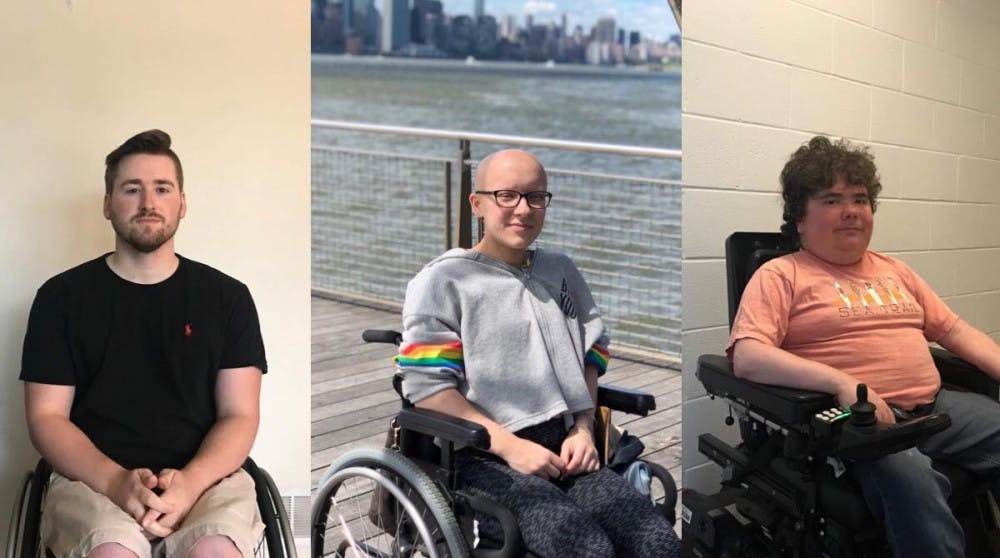Emily Tout had a problem with her class in Norton Hall last semester. She couldn’t get into the nearest bathroom.
Tout uses a wheelchair. She had to ask a friend to carry her from the hallway, into the stall, to the sink and then back out to her wheelchair. She roamed around the building looking for an accessible bathroom before resorting to the “embarrassing” tactic.
Connor Gow, who has been paralyzed from the waist down since September 2014, had to balance his laptop on his lap for three-hour stretches in Capen Hall last semester.
His classroom didn’t have an accessible table.
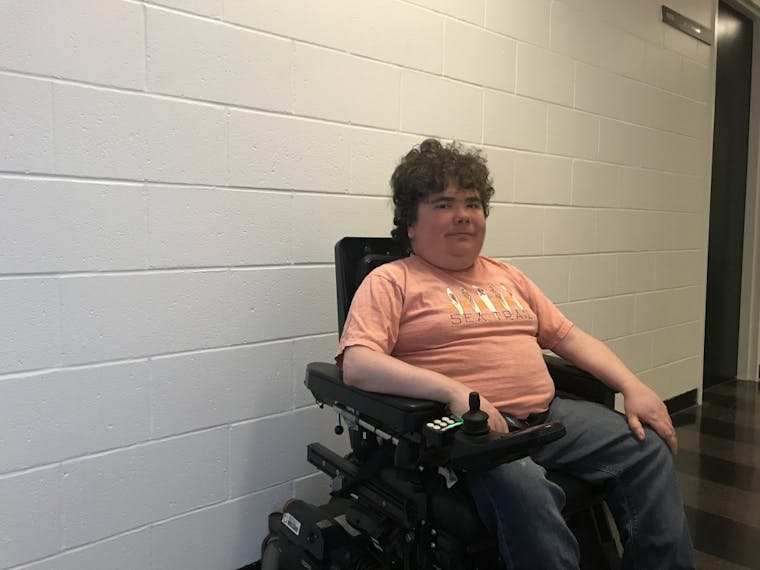
Graduate Student Zachary Dickman couldn’t get into one of his classrooms last semester since the door was already closed and he couldn’t get anyones attention inside.
Zachary Dickman missed class his first semester because he could not open the classroom door. His classroom lacked an accessible button, and he couldn’t get the attention of anyone inside.
Dickman said he worries what he would do in an emergency. UB’s plan for him to go into a “safe room” or a stairwell and call University Police seems unsafe, he said.
“If there was an actual emergency I don’t know what I would do, because if someone were to carry me down the stairs in an emergency situation they would probably break every bone in my body.”
These students are frustrated and say UB is not doing enough to accommodate them on campus or assure their safety.
About 1,000 students with disabilities registered with the accessibility office last academic year, according to Randall Borst, director of Accessibility Resources. But that number doesn’t include the many students with disabilities who attend UB but don’t alert his office, he said. Nationally, one in every 11 full-time college students reported having a disability.
Fifteen years ago, three UB students filed a lawsuit against UB and SUNY for accessibility issues and violation of both the Americans with Disabilities Act and Section 504 of the Rehabilitation Act of 1973. UB settled the case in 2004 and has spent $15.3 million to make the campuses more accessible, remediating 75% of the issues highlighted in the audit, according to Rhonda Ransom, a project manager of Facilities Design and Construction.
Some students say it isn’t enough.
“If UB made an effort to make things more accessible, it would literally change my life,” Tout said. “Even if UB acknowledged they’re not accessible, I want an honest heartfelt apology. They can’t just ignore it.”
Students with disabilities list other problems: being denied entry on campus buses and shuttles, construction workers removing and reinstalling accessible buttons, employees sometimes failing to completely shovel ramps covered in snow.
“UB has the means, the equipment and the employees to fix a door-control-activation button,” Tout said. “People are hired to do that. They’re just not doing it.”
Sharon Nolan-Weiss, the director of the Office of Equity, Diversity and Inclusion, said she is aware UB is not 100% compliant with ADA standards and said UB has been remediating accessibility over the years to meet standards.
“We have some of those old buildings where we’ll provide accessibility into major areas, but it may not be 100% up to ADA standards because of when the building was built,” Nolan-Weiss said.
She said UB did a lot of work after the audit in terms of curb cut, signage and retrofitting entrances by making them bigger and adding accessible push plates.
UB spokesperson John DellaContrada said in a statement that UB “is committed to ensuring that its programs, activities, services and facilities are accessible to everyone. Anyone with an accessibility concern is encouraged to report the situation to the University’s Office of Equity, Diversity and Inclusion.”
The students
Tout, a graduate social work and law student, has attended UB since 2014, but has attended in a wheelchair since 2018. She used a cane for eight months before becoming paralyzed from the waist-down after a brain and spine surgery.
Tout said there are “a lot of issues” with accessibility on campus. She attributed it to architect’s not considering accessibility when designing buildings.
“I didn’t think about using the accessible stall when I had full mobility or if the push plates worked or how to get to and from classes,” Tout said.
She said getting around UB is “very difficult.”
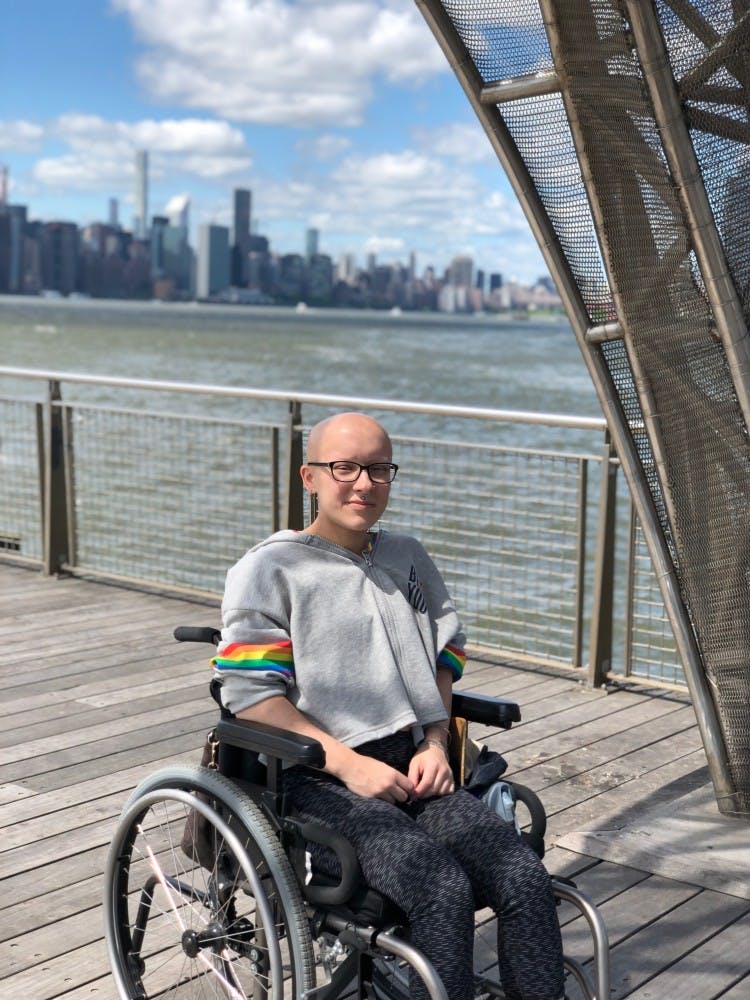
Graduate Student Emily Tout didn’t have an accessible bathroom in Norton Hall where she had a class last semester.
Some buildings on campus have broken accessible door-control buttons. Some of them have plates missing. Tout said she brought this to UB’s attention and Accessibility Resources told her to call when she encounters a button not working.
“When there’s ten [broken buttons] each day I don’t have the time to call and tell exactly what hallway and building,” Tout said. “It shouldn’t be on me to make things accessible because I have the disability.”
Nolan-Weiss said she alerts University Facilities when students come to her with complaints about door malfunctions.
“If someone came to me and said a door’s not working, I would submit a work order so the student doesn’t have to and then follow up and ask if it’s fixed,” Nolan-Weiss said.
Today, students say Michael Hall and Sherman Hall on South Campus and Norton Hall on North Campus don’t have accessible bathrooms. This leads students with disabilities to travel to different buildings to use a restroom.
Tout, Dickman and Gow said some bathrooms with the accessible sign on the door are not accessible, like on the second and tenth floors of Furnas Hall.
“I’m using a child-sized wheelchair and my child-sized wheelchair doesn’t fit in there, so that’s clearly not accessible,” Tout said.
“Sometimes I’ll have to go into another building to find a bathroom to use because the doors are too small and I can’t get all the way in there,” Gow, a graduate social work student, said.
Nolan-Weiss said not having accessible bathrooms adjacent to classrooms would be considered unequal program access and an immediate change would need to be made.
Tout recounted a time she had to wait for a bus on campus for over 45 minutes because three different drivers would not let her on their buses.
“I’ve had bus drivers tell me I couldn’t get on the bus because they either didn’t know how to put the straps on to strap my wheelchair in place or didn’t feel physically able,” Tout said.
Dickman, a graduate chemical engineering student, experienced a similar situation and said he, too, has been denied entrance on a campus bus.
“I had a driver who wasn’t sure how to strap my wheelchair down, and if the bus is getting full I always have to wait,” Dickman said.
Nolan-Weiss said she would “expect” the bus drivers to be able to know how to use the lifts so students in wheelchairs can use the bus transportation.
“If [the drivers] aren’t doing that, I think that’s something that we would need to talk to the transportation company about,” Nolan-Weiss said.
Director of Parking and Transportation Services Chris Austin said UB Stampede and shuttle drivers are trained during the onboarding process and “at minimum biannually” on the use of wheelchair lifts and providing services to students with disabilities.
“Each of the 28 Stampede buses and the 10 campus shuttles are equipped with lifts,” Austin wrote in an email. “All routes, at all times, have buses or shuttles that are able to provide services to passengers with disabilities.”
Some students in wheelchairs said the accessible dips in the sidewalk are difficult to access because they are not in line with the street.
“Even at the dips in the sidewalk where it’s supposed to be an accessible access point, I have to do a wheelie because there’s a little bump,” Tout said.
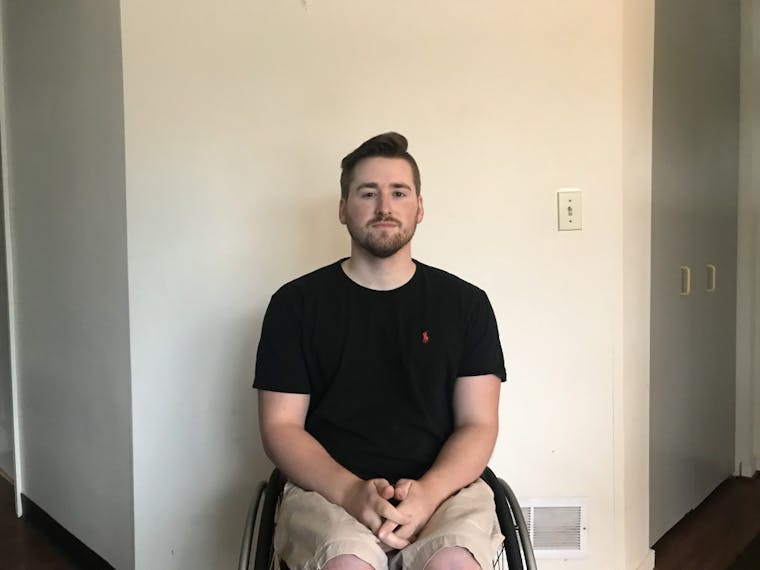
Graduate Student Connor Gow didn’t have an accessible table in Capen Hall where he had class last semester.
Gow became paralyzed from the waist-down in September 2014 when he fell 15 feet into a creek. He broke his collarbone, cut open his head and broke four ribs and his lower back.
He said winters on campus are more difficult, as the snow can make “rolling around” tough.
“I’ve seen instances where they leave a big pile of snow at the curb,” Gow said. “People don’t think about things like that, which before I got injured I guess I wouldn’t either.”
ADA access points such as the Student Union’s southeast entrance and Capen’s northwest entrance are supposed to be the first to be cleared once it snows at least two inches, according to UB’s Snow Removal Plan and Procedure. Nolan-Weiss said first and third-shift cleaners are assigned to keep entrances clear, but she said weather can make a previously accessible path inaccessible.
“The people who are clearing the snow might need more instruction to be very clear that they can’t just clear out the door, they have to clear the ramp too,” Nolan-Weiss said.
Gow has experienced the effects when paths are not properly cleared.
“On South Campus, there was a ramp completely covered in snow, they shoveled up in front of the door to go through but not the ramp,” Gow said.
Tout said because of the snow at the curbs, she sometimes needs to navigate around an entire building to find a place she can get on the sidewalk.
But even when building entrances are accessible, Tout and Gow both said they’ve had classrooms without accessible tables in them.
“I have classrooms that only have the chairs connected to the desk, so I have to use my arm strength to get myself from my chair into the desk and back into the wheelchair,” Tout said.
Dickman has been at UB since 2017 and now works in a lab on the tenth floor of Furnas Hall, where he said elevators are often broken. He said all three were down at one time. At the lab he works in Monday through Friday, he is not able to get in on his own, since there’s not an accessible button for the door.
In summer 2018, Furnas Hall was under construction and workers removed the push plate to get in from the outside, according to Dickman. There is another door with an accessible push plate on the other side, but he wasn’t able to use it as getting to it requires a step up. Another door to get inside doesn’t have a button at all, so he had to wait for someone to get there to let him in.
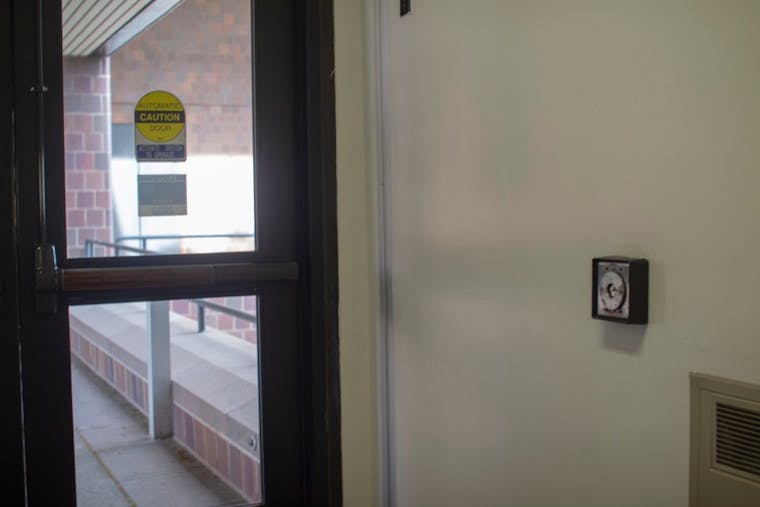
Missing door control activation button in Norton Hall.
Dickman said educating people on accessibility concerns is the first step to fixing the problem.
“It was obvious I was the first person in the chemical engineering graduate school they had to deal with in a wheelchair and I don’t think it’s something people are prepared for yet,” Dickman said.
The law
Ron Hager, a managing attorney at the National Disability Rights Network, said UB needs to accommodate all students.
“You should not have to go around to another building to go to the bathroom, that’s totally illegal,” Hager said. “UB had architects who were supposed to comply with ADA, so they could have sued their architects for negligence or breach of contract.”
Hager, an attorney involved in the 2000 case, said two federal requirements apply to UB –– the Rehabilitation Act of 1973 and the Americans with Disabilities Act of 1990. The Rehabilitation Act requires any building built after 1977 to be fully accessible, whereas the Americans with Disabilities Act, which made Titles I, II and III effective in 1992, applies to any existing structures. Since UB is federally funded, the university needed to make modifications to its existing structures. Hager said UB should have been fully accessible long ago.
When students filed the lawsuit in 2000, the university told attorneys that students were “complaining about nothing,” according to Hager. Yet, the attorneys who toured the campus found many significant places were not accessible. Lockwood and Capen were at the top of the priority list, even though UB opened them after 1977. The university decided to settle. The goal of the settlement was to make the university ADA-compliant.
“They have to make sure when looking at the entire campus, appropriate services and activities are accessible to people with disabilities,” Hager said. “Every program and service they offer must be available in an accessible location.”
Hager said all 103 academic buildings should have an accessible bathroom.
Stampede buses and North Campus shuttles are wheelchair accessible, according to UB’s website. But Hager said bus drivers must be properly trained to accommodate people with disabilities to declare this.
“The driver has to know how to use the straps and feel able to do that in order for the bus to actually be accessible,” Hager said.
Stephanie Woodward, director of advocacy at the Center for Disability Rights in Rochester, said universities often allocate money elsewhere and don’t prioritize making their campuses accessible.
“For schools to continuously receive funds to allow more students to get an education, I can’t imagine how they don't have the funds to continuously update and ensure there are accessible bathrooms,” Woodward said.
Web accessibility is another issue for college students. Pipe Dream, Binghamton University’s school newspaper, recently found UB and other SUNY schools in violation of Section 504 and Title II of the ADA for inequality of web access to people with disabilities.
In February 2018, UB had to submit a Web Accessibility Policy to the Office of Civil Rights to ensure all modifications would be compliant with Section 504 and ADA. Within 45 days of receiving approval of the Web Accessibility Policy, UB provided evidence of its adoption.
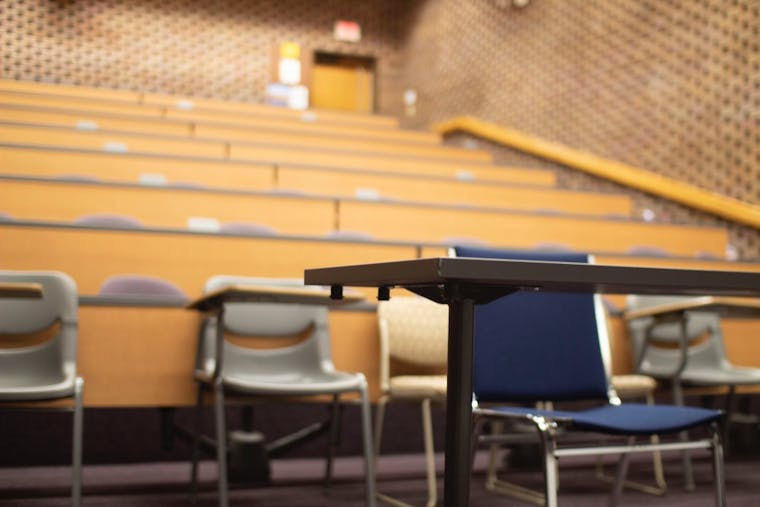
The classrooms in O’Brian Hall have the accessible seating at the bottom of a flight of stairs with no accessible entrance at the bottom of the lecture halls.
The university’s response
The Office of Equity, Diversity and Inclusion is responsible for making sure UB is compliant with ADA standards. Nolan-Weiss said many ADA regulations have been updated since they were first established and making the campus accessible is an “ongoing process.”
“During my time here, we’ve had to do a lot of rehab,” Nolan-Weiss said. “It’s always harder to retrofit a building and make it accessible than it is to build it from the ground up and make it accessible.”
Nolan-Weiss said most North and South Campus buildings were built prior to accessibility regulations, so some areas are not up to ADA standards. The Office of Equity, Diversity and Inclusion doesn’t keep a list of the buildings that aren’t compliant, according to Nolan-Weiss. Hager said UB is federally funded, and the ADA of 1990 required existing structures to make modifications.
Nolan-Weiss said this is not entirely possible with UB’s existing campus.
“There are some buildings where we don’t have to retrofit every single thing to ADA standard, because we’d basically be gutting the whole building and renovating every single thing,” Nolan-Weiss said.
Ransom has been involved with ADA improvements since May 2006. She said the first phase of projects from the 2004 audit addressed signage, entrances, accessible routes and bathrooms at highest-occupancy facilities. UB has addressed 66 of the 88 accessibility issues on the 2004 audit, according to Ransom. Ransom said addressing accessibility is a “daunting task” since ADA guidelines are continuously updated.
In 2011, The Spectrum published an article on problems students with disabilities face. At the time, the Disabilities Services office was inaccessible to students in wheelchairs and the Disability Testing Center did not offer an accessible emergency exit and was not equipped for the number and needs of students using it.
Since then, the office, now called Accessibility Resources, has been moved to Capen 60, which UB remodeled to accommodate wheelchairs. This included fixing signage that was not ADA-compliant, Borst said. But many classrooms still lack accessible tables and accessible buttons.
Nolan-Weiss said she encourages students to report these concerns online.
“If we don’t hear complaints, it’s hard for us to assess,” Nolan-Weiss said. “The more feedback we get, the better because it does matter to us.”
Gow said he thinks UB should give accessibility surveys to students so they could have a better idea of the struggles students with disabilities are facing on campus.
“I think it would be cool to start a club for people in wheelchairs, this way we could get together and talk about things like accessibility,” Gow said.
Tout said it would be “life-changing” if UB “made an effort” to become more accessible.
“The people who have to make the changes are the ones who are oppressed and struggling,” Tout said. “They have to fight for these changes because they don’t have any other option if these changes aren’t made.”
Brittany Gorny is the senior news editor and can be reached at brittany.gorny@ubspectrum.com and on Twitter @BrittanyGorny.
Brittany Gorny is the senior news editor.

